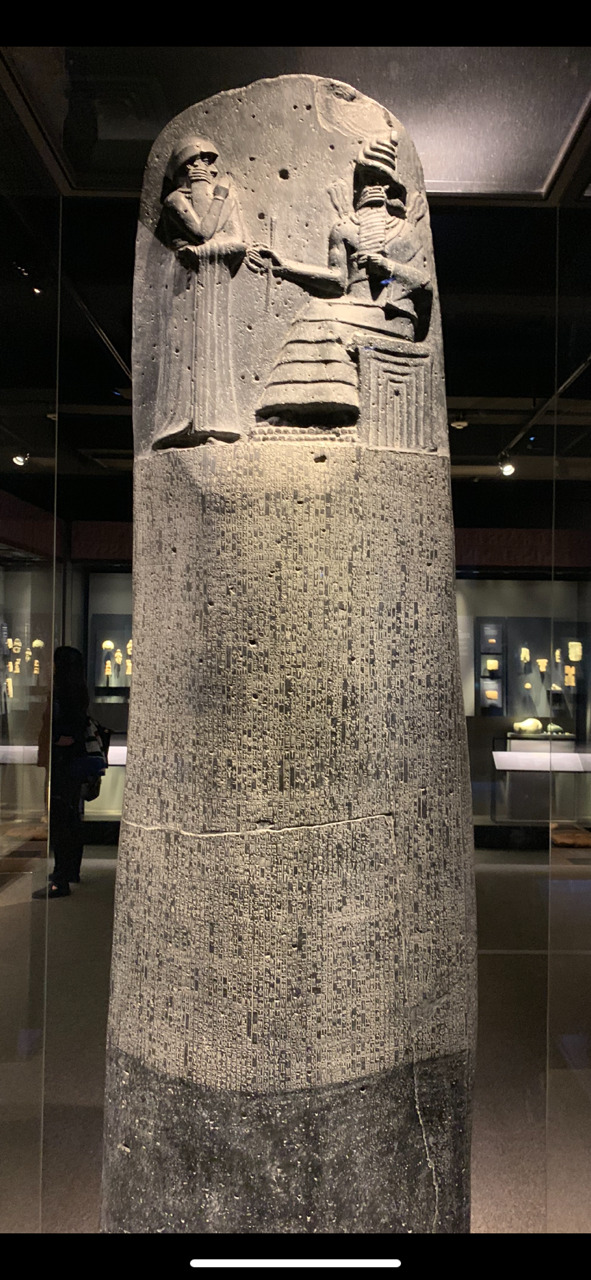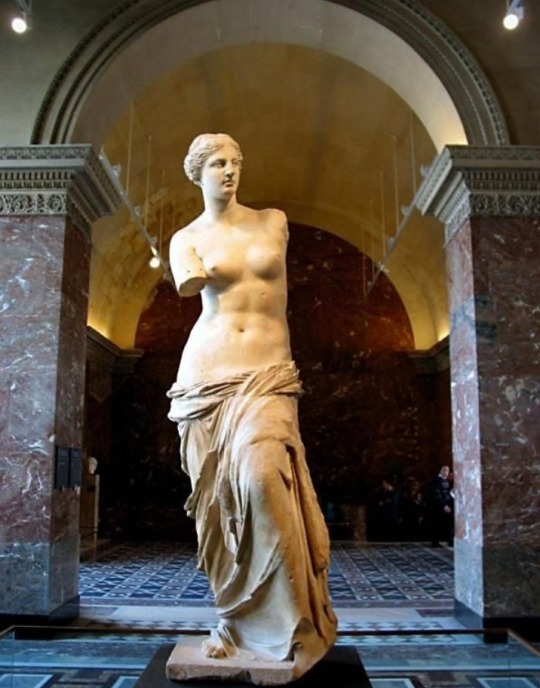#hammurabi's code
Explore tagged Tumblr posts
Text
It is not the first collection of written laws. It is among the first but there are many before it, notably the Code of Ur-Nammu (as of now the oldest that we've found, about 300-400 years older than Hammurabi's laws) or the Code of Eshnunna that is still a few years older. Granted, they both are not preserved on nice stelae, but we have them in writing. The code of Hammurabi borrows heavily from the codes that came before, but of course contains some new laws as well.

The Hammurabi Law Stele - first collection of written laws from the ancient world. 1750 BC - Babylon - Mesopotamia Iraq

301 notes
·
View notes
Text
youtube
0 notes
Text
New Post has been published on Books by Caroline Miller
New Post has been published on https://www.booksbycarolinemiller.com/musings/the-u-s-as-a-public-library/
The U. S. As A Public Library

Google sent out a 3-page, single-spaced summary of their revised terms of service the other day. Frankly, I’d rather read instructions for giving myself an enema. Plowing through the document’s legaleze is pointless. What voice do I have to make changes? None. Besides, Google assures me the new language will help customers understand what to expect… I already know what to expect. More advertising and increased liability. …if you violate our terms, our remedies aren’t limited to suspension or termination of your service but may include other remedies under applicable law. President Joe Biden rolled back several of Donald Trump’s digital trade policies, recently. That may be the reason for Google’s new terms. Civil rights organizations are giddy about the changes because Trump’s policies permitted tech companies to collect customers’ private information from their health providers, employers, and law enforcement agencies–information that could lead to discrimination in some communities. (“Bit Tech’s Big Meltdown Over A Big Consumer Policy Win On Trade,” by Owen Leary and Sarah Stevens, Public Citizen, March/April 2024, pg. 6) Naturally, these civil rights groups want Biden to do more. They worry about ways the military will use Artificial Intelligence, (AI) for example. Writer Savannah Wooten warns that automated systems could launch nuclear weapons without input from field commanders. Also, battlefield deep fakes–AI-generated reports, and documents–could wreak havoc in the fog of war. The challenges that lie ahead for the country are many, but Biden’s broom hasn’t been idle. Other of Trump’s policies have been swept away, including those touching upon religion. To his credit, the President repealed Trump’s rule that allowed faith-based charities to withhold assistance to the poor depending upon their religious affiliation. (“Nine Agencies Finalize Religious Liberty Rule,” FFRF, April 2004, vol 41 No 3, pg. 6.) Voters have much to contemplate in the 2024 election about the direction of the nation. The media prides itself on its role of informing the public, but mostly their headlines are scary. “The Country is Divided.” “Democracy is at Stake.” “America is on the Edge of Civil War.” Republicans and Democrats campaign with similar urgency, spinning dystopian visions of the future should they fail to win the White House. How real or chimerical these visions are, I don’t know. But this November, voters will make decisions that could lead to outcomes as different as Texas chili and vanilla ice cream. My guess is that a majority of voters prefer to end rancor and stalemate in government. We have seen the absurdity of asking Ukraine to defend itself with spitballs against the Russian army. What’s more, few of us want to become Putin’s satellite. If the country can’t heal its philosophical divide, a majority can make government functional by voting a straight ticket. They have a choice between a red or a blue wave. I predict the choice will be blue. Marjorie Taylor Greene and the MAGA wing of Republicans seem to be losing their grip on the party. Last week, House Speaker Mike Johnson, an extremist who orchestrated the January 6 insurrection, chose to plow new political ground. Rather than sustain a stalemate, he joined forces with Democrats to move key issues. He will do it again to save his speakership. In broader terms, I suspect humanity is growing tired of Hammurabi’s code of an eye for an eye. Benjamin Netanyahu may wish to drink the last drop of Palestinian blood, but a majority of us hunger for peace and the rule of law. Even without a majority in the U. S. House of Representatives, Biden and Democrats have been effective in their quest for social and economic progress. If polls are credible, many undecided voters, dubious at first of Biden’s candidacy, have begun to feel the benefits of his leadership. I predict that by November, a majority of them will join the blue wave. Am I a Pollyanna? Maybe so, even though I hunger for more and faster progress. I won’t hide my bias or pose as a conservative. If I were president, I would run the country like a library—a place where the whole of human knowledge resides and the sign above the door reads, “Ya All Come!”
#AI nuclear launch#battlefield deep fakes#Benjamin Netanyahu#Biden vs. Trump's digital policy#dystopian views of political parties#faith-based charities#Google contracts#Hammurabi's code#MAGA Republicn wing#Marjorie Taylor Greene#Mike Johnson#Owen Leary#Sarah Stevens#Savannah Wooten#scary media headlines
0 notes
Text
Ancient Law Unearthed From 5000 BC
Though the Code of Hammurabi is often cited as the first legal text, a much older stele dating to 5750 BC is thought to have held an earlier code of law, specifically dealing with mineral sales and metals of the proto-bronze age. The stele only has one law remaining intact but may have held over 20 total.

Unearthed from an ancient tin mine in Serbia, the Stele of Cassander The Nameless is a solid granite block measuring about 3 meters tall, engraved with Ancient Macedonian letters and mostly broken apart by time and mining activity.

Most of the laws on the stele are unreadable, but law 7 is fully intact and details the ownership rights of tin ingots, stating that it was not the miner nor the owner of the mine who had the right to sell the tin, but rather whoever participated in the smelting and reduction into the metal's pure form. Because of the past tense writing of ancient Hellenistic dialects, the first law recorded in human civilization translates exactly to, "He who smelt it dealt it."
477 notes
·
View notes
Text

164 notes
·
View notes
Text

"An Eye for and Eye, a Tooth for a Tooth."
I have been dying to draw Billford in the Code of Hammurabi because of my history of graphic design class. Chat how do we feel about this?
#gravity falls#fanart#book of bill#gravity falls fanart#the book of bill#alex hirsch#billford#artists on tumblr#bill cipher#stanford pines#gruncle ford#ford pines#i love you ford pines#billford doomed yapi#yaoi#doomed yaoi#old man yaoi#the code of hammurabi#an eye for an eye#aesocs
211 notes
·
View notes
Text
My original reaction to Poseidon's bit where he says "I'll take your son and gouge his eyes" etc etc was along the lines of "that seems a bit unnecessary, what did Telemachus do" and then I went wait, that was exactly what Odysseus did
It took me a bit too long to realize that that line was essentially implying Poseidon returning the favour, an eye for an eye
#or a son's vision for a son's vision#but that doesn’t flow as nicely so we're going with the hammurabi's code version#anyways. listen to the vengeance saga#it's fun and nothing bad happens#epic the musical#epic the vengeance saga
20 notes
·
View notes
Text
What was rule number one?
Newton: Objects at rest stay at rest and objects in motion unless acted upon by an external force?
Hamilton: The challenge: demand satisfaction, if they apologize no need for further action?
Hammurabi: if a man accuses another man of murder and can’t prove it, the accuser should be put to death?
James Madison: Freedom of religion?
Ha nerds, rule number one is don’t get caught-
“TIME TRAVEL POLICE, OPEN UP”
#shitpost#james madison#hammurabi’s code#hamilton musical#alexander hamilton#nerdy shit#isaac newton#us constitution#newtons laws of motion#history
8 notes
·
View notes
Text
Code of Hammurabi

By Mbzt - Own work, CC BY 3.0, https://commons.wikimedia.org/w/index.php?curid=16931676
The Code of Hammurabi was written between 1755-1850 BCE in Akkadian and inscribed on a basalt stele, or stone pillar, that is 2.25m (7' 4.5") tall. It was rediscovered in 1901 in Susa, Iran, was taken as plunder, and now is in the Louvre Museum in Paris France. It is the longest, most organized, and best preserved legal code of the ancient Near East. It is not the oldest, though. That title goes to the Code of Ur-Nammu, which was written around 2100-2050 BCE and was still being copied when Hammurabi's code was written. There did seem to be a change in focus, though, from compensation in the Code of Ur-Nammu to punishment in the Code of Hammurabi.

By Mbzt - Own work, CC BY 3.0, https://commons.wikimedia.org/w/index.php?curid=59794940
The top of the stele has an image of Hammurabi and Shamash, the Babylonian god of the sun and justice, on it. The figure on the left is standing, facing the other with one hand raised and the other held across the waist with fabric draped over his arm. The other is seated, wearing a multilayered skirt, holding a rod and ring in one hand, seemingly offering or accepting it, with what might be the back of the chair or rays coming from behind his shoulders. Whether the standing figure is Hammurabi or Shamash is up for debate. The Rod and ring are thought to be measuring tools or emblems of kingship.

By Deror avi - Own work, CC BY-SA 3.0, https://commons.wikimedia.org/w/index.php?curid=6042133
In total, there are 4130 lines of text on the stele. The first 300 go through Hammurabi's royal authority based on his family line and being chosen by Marduk, the patron deity of Babylon, and other gods conferred on him. He then enumerates his many qualities as king, including being 'pious' repeatedly. The last lines of the introduction state that the the writing of the Code was to fulfill Marduk's request to 'establish "truth and justice"…for the people'.
The next 3330 lines enumerate the laws of the Code. These lines cover approximately 282 laws covering a wide range of topics from offenses against the law such as leveling false charges through to property law, trade law to family law, as well as labor laws. It isn't, however, a complete codex of the laws of the land as it misses laws relating to shepherds though it covers laws relating to cattle herders. The laws are also written in an 'if…then…' format, lacking any generalized laws as well as covering some extremely unlikely events, like using goats (very unruly animals) to thresh grain. It also apparently wasn't used very much by judges at the time based on the fact that no legal documentation that we have references it. The closest is two references to 'a stele', but many judgments cite royal decrees, and many judgments run counter to the Code.
Some think that the Code isn't an actual list of laws, but an example of how judgments should be formulated, that it was meant to be a work of scholarship. Supporting this is that the laws come in pairs, such as one that says a physician should be paid if they perform a service that heals while they should be punished if the treatment causes death or blindness. Laws also differed based on the offender and the victim. There were three levels of people listed, awīlum, muškēnum, and wardum (male)/amtum (female). Wardum and amtum are the slave class. The other two are uncertain, but most likely 'gentleman' and 'commoner' respectively. There were also nuances within the classes themselves, based on laws that reference one being higher than another.
The final 500 lines reiterate that Hammurabi established the law, that the law should be read aloud to anyone who wrongheadedly brings a lawsuit, and a wish for good fortune on those that follow the laws and the wrath of the gods on those who ignore it. Twelve gods are invoked to punish those who don't acknowledge or adhere to the Code.
7 notes
·
View notes
Text
TODAY IN HISTORY

10 August 1793
The Louvre opened in Paris, eventually becoming the most visited museum in the world.
Check out the most famous works in the Louvre below! 👇🏼🧵

The Code of Hammurabi — 1750 BC

Venus de Milo — 2nd century BC

Winged Victory of Samothrace — 190 BC

Liberty Leading the People — 1830

The Raft of the Medusa — 1819

The Coronation of Napoleon — 1807

Psyche Revived by Cupid's Kiss — 1793

(L): The Seated Scribe — 2500 BC
(R): The Great Sphinx of Tanis — 2600 BC

Mona Lisa — between 1503 and 1506
#The Louvre#Paris#France#museum#Code of Hammurabi#Venus de Milo#Winged Victory of Samothrace#Liberty Leading the People#Raft of the Medusa#Coronation of Napoleon#Psyche Revived by Cupid's Kiss#Seated Scribe#Great Sphinx of Tanis#Mona Lisa#artworks#history#today in history#ancient civilizations
10 notes
·
View notes
Text
Values and Consciousness
Deeper into Unity Consciousness Universal Consciousness Consciousness is, by definition, the ability to make value judgments. To be conscious is to be aware — of something. Of what, exactly? I would argue that it is to be aware of the existence of value. To be aware that there are things of inherent value and other things of lesser or no value — in other words, to have a value system. To be…

View On WordPress
#AI#Bible#Code of Hammurabi#conflict#culture#Declaration of Independence#duality#education#flow state#ideas#illusion of separation#Meditation#morality#morals#Moses#my-featured-post#philosophy#qigong#religion#spirituality#technology#Ten Commandments#thought#unity consciousness#universal consciousness#value systems#values#Yoga
2 notes
·
View notes
Text
"A man's gotta have a code"
- Hammurabi, probably
7 notes
·
View notes
Quote
Creationists have also changed their name ... to intelligent design theorists who study 'irreducible complexity' and the 'abrupt appearance' of life—yet more jargon for 'God did it.' ... Notice that they have no interest in replacing evolution with native American creation myths or including the Code of Hammurabi alongside the posting of the Ten Commandments in public schools.
Michael Shermer
#Michael Shermer#quotelr#quotes#literature#lit#code-of-hammurabi#creation-myths#creationists#evolution#first-amendment#god-did-it#goddidit#hammurabi#intelligent-design#irreducible-complexity#jargon#myths#native-american#origin-of-life#pseudoscience#school#science#separation-of-church-and-state#sophistry#superstition#ten-commandments
3 notes
·
View notes
Text
Unearthing Ancient Civilizations
The Importance of Over 30,000 Preserved Cuneiform Writings Deciphering a Lost Language Insights into Daily Life and Culture The Epic of Gilgamesh Technological and Scientific Advances Religious and Mythological Texts The Role of Cuneiform in Modern Research Challenges in Preservation and Interpretation Enhancing Accessibility and Understanding Book Recommendations Online Resources and…

View On WordPress
#Assyriology#Babylonian mathematics#British Museum#Code of Hammurabi#Cuneiform#Cuneiform Digital Library Initiative (CDLI)#Epic of Gilgamesh#Henry Rawlinson#Louvre Museum#Mesopotamia#Mesopotamian mythology#Sumerians
7 notes
·
View notes
Text

Captain Constance L. Hanaway of the first division, FDCM
#oc#my art#sun-floweroo#my drawing#sketch#oc art#story#story ideas#Hammurabi’s code#Hammurabi’s code oc#original character#original story
5 notes
·
View notes
Text
do I write the artem wing x saeyoung choi one-shot or...?
#me when I realize my 2 favorite male presenting love interests are genuinely compatible#shocked pikachu face#mod mumbles#they both like fishing and cars and have strong senses of justice!#except artem believes in the legal system and saeyoung believes in hammurabi's code#But they're both committed to the bit#also autistic coded... so very autistic coded.....
2 notes
·
View notes